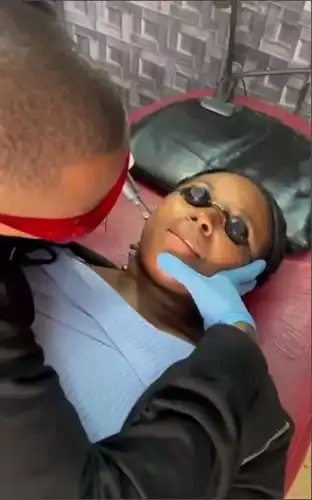What causes Black/ Dark Spots on the body
Black or dark spots on the body can have various causes, ranging from external factors to underlying health conditions. Here’s an overview of common causes:
- Hyperpigmentation
– A condition where excess melanin production causes dark spots. Triggered by:
→ Sun Exposure: UV rays stimulate melanin production, leading to sunspots.
→ Post-inflammatory Hyperpigmentation (PIH): Results from skin injuries like acne, cuts, or burns. - Acne Scarring: Pimples, blackheads, or cystic acne can leave behind dark spots once healed.
- Hormonal Changes
– Melasma: Often caused by pregnancy, hormonal treatments, or birth control pills.
– Dark patches typically appear on the face, chest, or stomach. - Skin Injuries
– Cuts, bruises, insect bites, or burns can cause dark spots as the skin heals.
– Friction: Repeated rubbing (e.g., thighs, underarms) can darken the skin over time. - Sun Damage
– Prolonged sun exposure without sunscreen protection can lead to:
→ Age spots (Solar Lentigines).
→ Darkening of exposed areas like shoulders, arms, and chest. - Medication Side Effects
– Certain medications, such as:
→ Antibiotics (e.g., tetracyclines).
→ Hormonal drugs.
→ Chemotherapy agents.
→ Can lead to skin pigmentation. - Medical Conditions
– Addison’s Disease: Causes darkening of skin folds, knuckles, and gums.
– Diabetes: Leads to a condition called acanthosis nigricans, where skin folds darken. - Fungal Infections
– Tinea Versicolor: A yeast infection that leaves patches of lighter or darker skin.
– Ringworm: Can cause dark spots after healing. - Aging: As the skin ages, it becomes more prone to sunspots and uneven pigmentation.
- Genetic Predisposition: Some individuals are genetically prone to developing hyperpigmentation.
- Poor Lifestyle Habits: Smoking, dehydration, and unhealthy diets can exacerbate skin discoloration.
How to Identify the Cause
- Location: Spots on the face may relate to acne or sun damage; spots on the back or chest may result from acne scars or fungal infections.
- Appearance: Raised or itchy spots could indicate an allergic reaction or infection.
Treatment options for black or dark spots on the skin depend on the cause of the spots. In some cases, they may fade on their own over time, but there are also treatments available, such as topical creams, chemical peels, and laser therapy. It’s important to consult a professional to determine the cause of the spots and the most appropriate treatment.
Black/Dark Spots Laser Treatment Procedure
Laser treatments are one of the most effective ways to reduce or eliminate black or dark spots caused by hyperpigmentation, sun damage, or scars. Here’s a detailed guide on how the procedure works:
- Types of Lasers Used
Different lasers are chosen based on the type, depth, and severity of the dark spots.
– Ablative Lasers: Remove the top layer of skin to promote regeneration.
→ Example: Carbon Dioxide (CO2) Laser, Erbium YAG Laser.
– Non-Ablative Lasers: Target melanin in the skin without damaging the surface.
→ Example: Q-Switched Laser, Nd:YAG Laser, Fraxel Laser.
– Pulsed-Dye Laser: Reduces redness and works on pigmented spots. - Pre-Treatment Preparation
– Consultation:
→ A dermatologist assesses the skin type, the cause of the spots, and recommends the best laser type.
→ Discuss medical history to ensure no contraindications like active infections or certain medications.
– Skin Prep:
→ Avoid sun exposure, retinoids, and exfoliants 1-2 weeks before the procedure.
→ A topical numbing cream may be applied before the treatment to minimize discomfort. - The Procedure
– Duration: Typically 15–60 minutes, depending on the treatment area.
– Steps:
→ The skin is cleansed thoroughly.
→ A laser device is directed at the target areas to emit concentrated light beams.
→ The laser energy breaks down melanin in the dark spots, which is later absorbed or shed naturally.
→ For non-ablative treatments, the laser stimulates collagen production for skin repair. - Post-Treatment Care
– Immediate Effects:
→ Skin may appear red, swollen, or slightly warm for a few hours to a day.
→ Dark spots might temporarily darken before lightening as they heal.
– Aftercare Tips:
→ Apply soothing ointments or aloe vera as prescribed.
→ Use sunscreen (SPF 50 or higher) religiously to protect healing skin.
→ Avoid scrubbing, exfoliating, or using harsh skincare products for a few days.
→ Stay hydrated and use a gentle moisturizer to promote healing. - Results and Follow-Up
– Timeline:
→ Initial results are visible in 1–2 weeks, with full effects in 4–6 weeks.
→ Multiple sessions (2–6) may be required for deeper or stubborn spots.
– Longevity: Results are long-lasting with proper sun protection and skincare. - Risks and Considerations
– Potential Side Effects:
→ Temporary redness, swelling, or mild discomfort.
→ Rare cases of scarring, pigmentation changes, or infection.
– Not Suitable For:
→ Pregnant individuals.
→ People with active infections, open wounds, or keloid-prone skin.
Types of Lasers used in Treatment of Black/Dark Spots
Here’s a detailed overview of the types of lasers used in the treatment of black/dark spots and how they work:
- Ablative Lasers
Ablative lasers remove the outer layers of damaged skin, promoting new skin growth and reducing pigmentation.
– Carbon Dioxide (CO2) Laser:
→ Targets deeper layers of the skin.
→ Effective for severe pigmentation, scars, and deep wrinkles.
→ Requires more downtime due to skin resurfacing.
– Erbium YAG Laser:
→ Targets moderate pigmentation with less impact on surrounding tissue.
→ Faster healing compared to CO2 lasers. - Non-Ablative Lasers
Non-ablative lasers work beneath the skin’s surface to target pigmentation without damaging the outer layer.
– Fraxel Laser:
→ Stimulates collagen production while targeting melanin.
→ Effective for sunspots, melasma, and acne scars.
→ Minimal downtime.
– Nd:YAG Laser:
→ Penetrates deeper into the skin.
→ Effective for darker skin tones and stubborn pigmentation.
→ Commonly used for age spots, melasma, and tattoos.
– Q-Switched Laser:
→ Emits high-energy light to break down melanin into smaller particles.
→ Effective for freckles, sunspots, and post-inflammatory hyperpigmentation (PIH).
→ Also popular for tattoo removal. - Fractional Lasers
Fractional lasers deliver light in a grid pattern, treating small areas of the skin while leaving surrounding tissue intact for faster healing.
– Fraxel Dual:
→ Combines non-ablative technology with fractionated light.
→ Treats pigmentation, scars, and fine lines with minimal downtime.
– PicoSure Laser:
→ Uses ultra-short pulses to shatter melanin.
→ Ideal for melasma and dark spots caused by acne or sun exposure. - Pulsed-Dye Lasers (PDL)
– Uses a concentrated beam of light to target blood vessels and reduce redness or discoloration.
– Best for redness-induced dark spots, post-inflammatory marks, and vascular lesions. - Intense Pulsed Light (IPL)
– Though technically not a laser, IPL uses broad-spectrum light to target melanin and hemoglobin.
– Effective for sunspots, freckles, and mild pigmentation issues.
– Minimal downtime but requires multiple sessions. - Ruby Laser
– Targets specific pigmented lesions, such as age spots and freckles.
– Not commonly used today due to advancements in Nd:YAG and Q-Switched lasers.
Choosing the Right Laser:
The choice depends on several factors, including:
- Skin Type: Darker skin tones often benefit from Nd:YAG or PicoSure lasers to minimize the risk of hypopigmentation or burns.
- Type of Pigmentation:
– Surface-level spots (e.g., freckles, age spots): Fraxel, IPL.
– Deeper pigmentation (e.g., melasma, PIH): Nd:YAG, Q-Switched. - Desired Results and Downtime:
– Ablative lasers provide dramatic results but require longer recovery.
– Non-ablative lasers are gentler with less downtime.
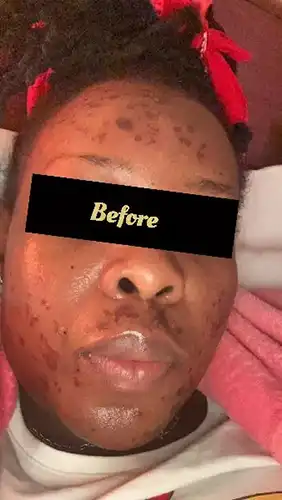

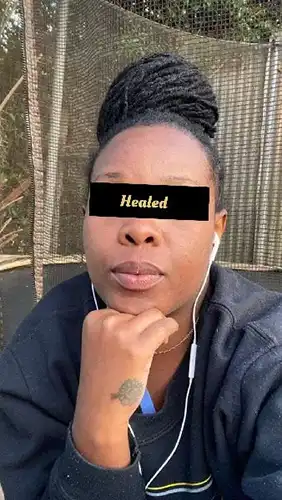


Schedule Appointment
How to Prepare for the Black Spot Laser Treatment Procedure
Proper preparation before a black spot laser treatment ensures safety, minimizes side effects, and enhances results. Here’s how to prepare:
- Consultation with our Professional
– Schedule a consultation to discuss:
→ Your medical history (e.g., skin conditions, medications, allergies).
→ The cause of the black spots (e.g., sun damage, acne scars, melasma).
→ Expected results and the number of sessions required.
– A patch test may be performed to check for skin sensitivity to the laser. - Avoid Sun Exposure
– Stay out of direct sunlight for at least 2 weeks before the procedure.
– Apply a broad-spectrum sunscreen (SPF 50+) daily to protect the skin.
– Wear protective clothing, hats, and sunglasses when outdoors. - Stop Certain Skincare Products
– Discontinue the following at least 1–2 weeks before the treatment:
→ Retinoids (e.g., tretinoin, retinol).
→ Exfoliants (e.g., AHAs, BHAs, or scrubs).
→ Bleaching agents (e.g., hydroquinone).
→ Products containing Vitamin C or other active ingredients.
– Use gentle, fragrance-free skincare products instead. - Avoid Tanning: Refrain from tanning beds, self-tanners, or any form of artificial tanning for 2–4 weeks before treatment.
- Stop Blood-Thinning Medications
– Avoid aspirin, ibuprofen, or blood-thinning supplements (e.g., fish oil, vitamin E) for 7 days prior to the procedure, unless otherwise directed by your doctor.
– Inform your dermatologist about any prescription medications. - Avoid Hair Removal Methods: Do not wax, tweeze, or use hair removal creams on the treatment area for at least 2 weeks before the session.
- Cleanse Your Skin
On the day of the procedure:
Wash your face or treatment area with a mild cleanser.
Avoid applying makeup, lotion, sunscreen, or perfume. - Stay Hydrated: Drink plenty of water in the days leading up to the procedure to keep your skin hydrated and promote faster healing.
- Manage Expectations
– Understand that:
→ Multiple sessions may be needed for optimal results.
→ Temporary side effects like redness, swelling, or darkening of spots are normal.
→ Strict aftercare is required to maintain results. - Plan Your Schedule: Laser treatments may require downtime, especially for ablative lasers. Schedule your session when you can rest and avoid sun exposure.
Black/Dark Spots Laser Treatment Aftercare
After a laser treatment for black/dark spots, proper aftercare is crucial to ensure effective healing, minimize side effects, and achieve the best results. Here’s a comprehensive guide to laser treatment aftercare:
Immediate Aftercare (First 24-48 Hours)
- Keep the Treated Area Cool and Calm:
– Apply a cold compress or ice pack (wrapped in a clean cloth) to reduce swelling and redness.
– Avoid hot showers, saunas, or activities that cause excessive sweating. - Use Prescribed Ointments: Apply any dermatologist-recommended creams or healing ointments (e.g., Aquaphor, petroleum jelly) to soothe the skin.
- Avoid Touching or Scrubbing: Refrain from rubbing, picking, or scratching the treated area to prevent scarring and infection.
Daily Aftercare (1–2 Weeks Post-Treatment)
- Sun Protection is Vital
– Apply a broad-spectrum sunscreen (SPF 50 or higher) daily, even indoors.
– Reapply sunscreen every 2–3 hours if exposed to sunlight.
– Avoid direct sun exposure and wear protective clothing, hats, and sunglasses. - Keep the Skin Hydrated
– Use a gentle, fragrance-free moisturizer to prevent dryness and peeling.
– Hydrate from within by drinking plenty of water. - Use Gentle Cleansers: Wash the treated area with a mild, non-irritating cleanser. Avoid harsh soaps or exfoliating products.
- Avoid Harsh Products
– Skip retinoids, alpha hydroxy acids (AHAs), beta hydroxy acids (BHAs), or any active skincare ingredients for 1–2 weeks.
– Avoid makeup or skincare with fragrances, alcohol, or potential irritants.
What to Expect During Healing
- Darkening of Spots: Treated dark spots may temporarily darken before flaking off naturally.
- Peeling or Scabbing: Mild peeling or scabbing is normal; do not pick at it.
- Redness and Sensitivity: The skin may feel tender and appear red for a few days to a week.
Long-Term Aftercare (2–6 Weeks Post-Treatment)
- Continue Sun Protection: Long-term sun care is essential to prevent the reappearance of dark spots.
- Introduce Actives Slowly: Gradually reintroduce active skincare like retinoids or vitamin C after consulting your dermatologist.
- Maintain a Gentle Routine: Stick to products that promote skin hydration and repair.
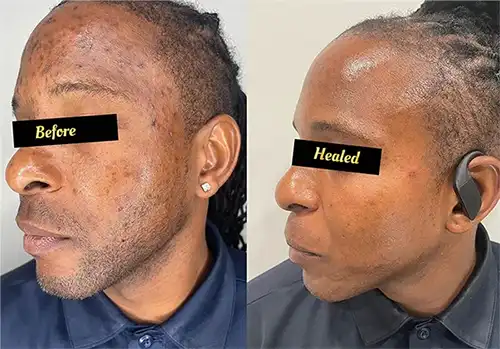


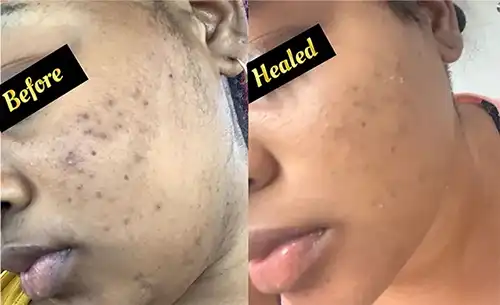


Cost of Black/Dark Spots Laser Treatment in Nairobi, Kenya
The cost of laser treatment for black/dark spots varies based on factors such as the type of laser used, the treatment area, the number of sessions required, and the clinic’s location. Here’s an overview to give you an idea of the pricing:
Average Cost per Session
- Ablative Lasers (e.g., CO2, Erbium YAG):
– Ksh. – Ksh. per session.
– These are more intensive and typically require fewer sessions (1–3). - Non-Ablative Lasers (e.g., Fraxel, Nd:YAG):
– Ksh. – Ksh. per session.
– Effective for mild to moderate pigmentation and require multiple sessions (3–6). - Q-Switched Lasers:
– Ksh. – Ksh. per session.
– Commonly used for deeper pigmentation issues, like melasma or post-inflammatory hyperpigmentation. - PicoSure Laser:
– Ksh. – Ksh. per session.
– Effective for stubborn pigmentation with fewer side effects. - Intense Pulsed Light (IPL):
– Ksh. – Ksh. per session.
– Suitable for surface-level pigmentation like sunspots or age spots.
Factors Affecting Costs
- Size of the Treatment Area:
– Small areas (e.g., face): Lower cost.
– Large areas (e.g., back, chest): Higher cost. - Number of Sessions Required:
– Mild pigmentation may clear in 1–3 sessions.
– Stubborn or deep pigmentation may need 4–6+ sessions. - Parlour Location and Expertise: Parlours in urban areas or those run by renowned dermatologists often charge more. Rebel Inks Tattoos, Tattoo Removal, and Body Piercings Parlour is located in the heart of the Central Business Disrict (CBD) in Nairobi, Kenya, and is easily accessible to both locals and foreigners in the country.
- Additional Costs:
– Consultation fees: Ksh. – Ksh.
– Aftercare products or follow-up visits may add to the overall cost.
Estimated Total Cost for a Full Treatment
- Mild Pigmentation: Ksh.– Ksh.
- Moderate to Severe Pigmentation: Ksh.–Ksh.+ (multiple sessions).
Benefits of Black/Dark Spots Laser Treatment
Laser treatment for black or dark spots offers several benefits that make it an effective option for addressing hyperpigmentation, scars, and uneven skin tone. Here’s a detailed breakdown of its advantages:
- Effective Removal of Dark Spots
– Precision: Lasers target the pigmented areas specifically without harming the surrounding skin.
– Results: Reduces or eliminates spots caused by sun damage, acne scars, melasma, or age spots. - Stimulates Skin Regeneration
– Encourages collagen production, leading to healthier and rejuvenated skin.
– Improves skin texture and tone in addition to lightening dark spots. - Suitable for Various Skin Concerns
– Laser treatment can address multiple pigmentation issues, such as:
→ Freckles.
→ Post-inflammatory hyperpigmentation (PIH).
→ Sunspots (solar lentigines).
→ Acne scars and blemishes. - Non-Invasive and Safe
– Modern laser technology minimizes discomfort and downtime.
– Non-ablative lasers treat the skin gently, making it safe for sensitive areas like the face.
- Customizable Treatments
– Dermatologists tailor the laser type and intensity based on your skin type, condition, and severity of spots.
– Suitable for a wide range of skin tones, including darker skin types, when using lasers like Nd:YAG or PicoSure. - Long-Lasting Results
– With proper skincare and sun protection, the results can last for years.
– Effective prevention of recurring spots when combined with good lifestyle habits. - Minimal Downtime: Many laser treatments, especially non-ablative ones, allow you to resume daily activities within a day or two.
- Boosts Confidence
– Removes visible imperfections, resulting in smoother, more even-toned skin.
– Enhances overall skin appearance, giving you a youthful and radiant look. - Safe for Delicate Areas: Advanced laser systems can safely treat delicate areas such as around the eyes, neck, and hands, where pigmentation often occurs.
- Quick and Convenient
– Sessions are relatively short, lasting between 15–60 minutes.
– Suitable for busy individuals who want effective results without significant time commitment. - Reduces Future Skin Damage: Some lasers (e.g., Fraxel) not only treat pigmentation but also improve skin quality by repairing sun damage and boosting elasticity.
- Multi-Purpose Benefits
– Aside from removing dark spots, laser treatments can:
→ Minimize fine lines and wrinkles.
→ Tighten skin.
→ Reduce redness and vascular lesions.
Possible side effects of Black/Dark Spots Laser Treatment
While laser treatment for black or dark spots is generally safe, it can have potential side effects depending on the type of laser, skin type, and individual response. Here’s a detailed overview of the possible side effects:
Common Side Effects
- Redness and Swelling
– Treated areas may appear red and swollen immediately after the procedure.
– These symptoms typically subside within a few hours to a few days. - Darkening of Treated Spots
– Known as “micro-crusting,” dark spots may temporarily darken before flaking off as the skin heals.
– This is a normal part of the process and resolves within a week or two. - Peeling or Flaking
– Treated skin may peel or flake as it regenerates.
– Proper aftercare helps minimize discomfort and promote healing. - Sensitivity
– The treated area might feel tender or sensitive, especially to touch or heat.
– Skin sensitivity can last a few days to a week. - Mild Pain or Discomfort
– A stinging or burning sensation may occur during or shortly after the procedure.
– This is usually managed with topical numbing creams and cool compresses.
Less Common Side Effects
- Hyperpigmentation (Dark Spots): In rare cases, the treatment may trigger post-inflammatory hyperpigmentation (PIH), especially in darker skin tones.
- Hypopigmentation (Light Spots): Loss of pigment in the treated area can occur, particularly with aggressive treatments or in individuals with darker skin.
- Scarring
– Improper care during healing or overly aggressive laser settings may lead to permanent scarring.
– Rare but possible if the skin is not properly prepared or aftercare is neglected. - Infection
– Open skin from ablative lasers may develop an infection if not kept clean.
– Signs include increased redness, warmth, or pus. - Blistering or Crusting
– Blisters may form, especially with ablative lasers or sensitive skin.
– They typically heal without scarring when properly managed. - Allergic Reactions: Rarely, individuals may react to topical numbing creams or post-treatment products.
Risk Factors for Side Effects
- Skin Type
– Darker skin tones (Fitzpatrick types IV–VI) are more prone to hyperpigmentation or hypopigmentation.
– Using the wrong type of laser increases risks. - Aggressive Settings: Overly intense laser settings or frequent treatments can damage the skin.
- Sun Exposure: Failing to avoid the sun before and after treatment can lead to pigmentation issues or burns.
- Improper Aftercare: Not following post-treatment instructions increases the risk of infections and delayed healing.
How to Minimize Side Effects
- Choose an Experienced Dermatologist: Work with a certified and experienced professional to ensure proper settings and techniques.
- Pre-Treatment Preparation
– Avoid sun exposure, exfoliants, and tanning products.
– Follow all pre-treatment guidelines provided by your doctor. - Follow Aftercare Instructions
– Keep the treated area clean and moisturized.
– Use sunscreen diligently to protect sensitive skin. - Be Patient: Some side effects like redness, swelling, or darkening are temporary and part of the healing process.
Get In Touch
For more information on the list above and any other special services,please call or come in for free consultation
Testimonials
After he pierced my industrial piercing and seeing his amazing work, I feel even more excited about getting my tattoo with him in January. I’m really looking forward to it!
I am extremely happy with my new 'Safari' tattoo from Eric at Rebel Inks! The quality of the artwork is fantastic. Eric is a true professional and an amazing artist.
The preparation and design process was thorough and collaborative. He was very patient with my specific requests, including making sure all the elements, which hold personal meaning, were perfect.
The service was friendly and highly professional from start to finish. Despite the 8-hour session, Eric was a pleasant person to spend the time with.
The aftercare guidance and follow-up have been excellent and careful, which has made the healing process easy and better than expected.
I highly recommend Eric for anyone looking for a thoughtful, talented, and caring tattoo artist.
I recommend them 💯
I would definitely recommend if you’re thinking of getting a piercing!
The staff were super friendly, explained everything clearly, and made me feel so at ease. They answered all my nervous questions (and I had many questions),
They walked me through the whole process, gave detailed aftercare instructions, and even followed up afterward to check how I was healing 🫶
Clean, professional, and full of good vibes.
Would 100% recommend . Definitely making a second trip here.
This was the second tattoo I got and I wish I could have come to Eric for my first one! He gave me really great after-care directions for the tattoo as well as a little jar of his own Vaseline-type stuff to put over my tattoo while it was healing! He even put second skin over my tattoo so that I didn’t have to worry about it for the first few days. Now THAT’S good service. My first tattoo artist didn’t do none of that lol.
After the session Eric didn’t rush me and my friend out, he chatted with us and even when he found out I was an artist too— really encouraged me to keep creating and to find a community of artists to support me. I almost cried because I’ve had such a hard time with my own art the past couple of years, it meant so much to me to have a fellow very talented artist say that to me. 🤍🤍🤍
Eric you’re amazing, don’t ever stop creating and just know you’ve impacted lives all over the world!🫶🏻 thanks so much for everything!!
From the moment I walked in, Eric was professional, welcoming, and attentive. He made sure I was comfortable throughout, provided everything I needed, and explained every step of the process. The tattooing itself was unbelievably smooth - I genuinely felt no pain compared to my previous tattoos over the last 22 years.
Eric also gave me excellent aftercare guidance and products, and thanks to that, my tattoo healed beautifully. The attention to detail, precision, and shading are absolutely stunning. This is hands-down the best tattoo I've ever had, and I will be flying back to Nairobi for any future ink.
If you want incredible art, a professional experience, and a talented artist who truly cares about his clients, Rebel Ink is the place to go!
From start to finish, the service was exceptional. The piercer was professional, knowledgeable, and made me feel completely comfortable. The cleanliness of the place was above and beyond — everything was spotless and hygienic, which really put me at ease. Highly recommend for anyone considering a piercing!
Shout out to Eric😘
We ended up changing the jewelry three times to ensure I had the best fit and avoided any signs of rejection, and he always listened to my suggestions as a client, which I really appreciated. Now, three months in, my piercing is healing beautifully, with no sign of rejection. Highly recommend for anyone who values a piercer who cares about your comfort and healing journey!
What stood out the most was the aftercare Eric checked in with me even three weeks later to see how the tattoo was healing. That kind of follow-up shows how much he truly cares about his work and his clients.
I’m very satisfied and will definitely be coming back for my next piece. Highly recommend!
The piercing wasn't as painful as I had thought and the process was quick and satisfactory. I love it!!!
The piercing is healing well thanks to the aftercare instructions and follow-up. I would highly recommend Rebel Inks
Eric also did a belly button piercing for a friend, guiding her through the process, doing the piercing and then explaining the after care to her.
The shop is on the 3rd floor, with the entrance to the stairs near an alleyway on the left. The shop is perfect size, clean, and attractive looking. The mural is pretty dope.
Thank you for the amazing service! 🔥👅✨
I got piercibgs there and the process was really good. My biggest concern was hygiene but that wasn't an issue at all, they use new needles and they sanitize them.
The service itself was also welcoming.
I was informes of everything i needed to know beforehand.
10/10 would recommend!
Eric was so calm and patient with my almost 2 year old lady. It was such a clean and hygienic process. We will definitely be back for our second rounds of piercings and maybe even another tattoo!
They assess the area before any art and advise one accordingly. They also give one post clean up process and also do a check up after the body art projects. Overall, I loved my experience and I’m hooked. 👍
Will definitely come back next time I’m in town 🙂
He listened to what I actually wanted and made sure he could fit in the time before I flew back home.
The shop is clean & private and is easy enough to find.
Eric has even checked in a couple of times since to make sure all is good.
I would totally recommend Eric! I absolutely love my Elephants!
I had a very easy healing period and always follow up from Eric to check on my progress...I would highly recommend if you are a first timer because from my experience all went very well and attention to detail
Thank you for a good job and looking forward to send all my friends your way
And all the best with the new year 2025!
From the moment I walked in, the staff was super friendly and made me feel at ease. The studio had a clean, professional atmosphere, which immediately put me at ease. My piercer was incredibly skilled and explained every step of the process, ensuring I was comfortable the entire time. The piercing was quick and practically painless, and the aftercare instructions were clear and easy to follow. I can tell they really care about the health and safety of their clients.
Overall, a fantastic experience—I highly recommend Rebel Inks and Tattoos for anyone looking to get pierced or tattooed!
They do follow up after their services
Eric's Studio isn’t just a place to get a tattoo—it’s an experience. The combination of professionalism, artistic talent, and a welcoming environment makes it a standout destination for anyone considering a tattoo.
I highly recommend Eric’s Studio to both first-timers and seasoned tattoo enthusiasts. If you’re looking for a high-quality tattoo and an enjoyable experience, this is the place to go.
I would definitely recommend their services again and again
Thank you Rebel Ink
My piercings are healing ❤️🩹 well
I would 💯 recommend
I will definitely come back for more .
Two, all the equipments he used for the piercings were new and/or sterilised.
Three, the parlour itself was very clean and was up to par with the hygiene standards.
Four, Eric provided effective aftercare instructions, making sure I knew exactly how to take care of my new piercings and he kept in touch and continues to do so, to check on the healing progress.
I highly highly highly recommend this place!!!
Would definitely recommend them to friends and go back for other piercings
Not only was the piercing process smooth, but he also provided thorough aftercare instructions, making sure I knew exactly how to take care of my new piercings. What really impressed me was that he keeps in touch to check on how the healing is progressing – a sign of true care for his clients.
The shop maintains a high standard of hygiene, and the atmosphere is welcoming and comfortable, which really added to the positive experience. I highly recommend this place to anyone looking for a professional and caring experience. I’ll definitely be coming back for any future piercings!
My appreciation for the excellent customer service I received. The follow-ups were prompt, and I truly appreciated the gentleness and professionalism throughout. Thank you!"
"Looking for professional eyebrow microshading removal? Look no further!"
The customer care is top tier 👌🏾👌🏾.
Wonderful place to get tattoos and piercings. 💯💯
Eric goes ahead to follow up on his clients progress and gives good advice each time I reach out to him.
I would recommend Reble tattoos anytime.
Good job bro we really appreciate.
Ohh and the price is very fair.
The environment was clean , procedure was sterile and the jewelry used are of the best quality.
He followed up with me during the healing process, he educated me on what I needed to do for my aftercare.
Eric is confident, skilled , experienced and the best piercer. Highly recommend Rebel inks.✨
Definitely recommend!
Great experience.
Eric definitely know what he is doing .
I got exactly what I wanted 2 tiny tats on the same finger .
He was kind and patient throughout the session.
Healing process has been good .
Aftercare services were given and regular checkups on the healing process were done.
I would 💯recommend.
Eric gave me the best reception as it was my first time there,and made me trust him all the way. I appreciate good services.
There services are also affordable not to forget 😊.
He was also invested in the aftercare and would ensure I follow the do's and don'ts in taking care of the tattoo and ensuring proper healing and maximum ink retention.
Would highly recommend Rebel Inks Tattoos.
Rebel Inks Tattoo offer the best,affordable and quality tattoo removal services.If you have unwanted ink,choose Rebel Inks Tattoo,they're the best of the best and the professionalism is a top notch.They ensure you're free from unwanted ink with their Laser Tattoo Removal Technology...
I did a Laser Tattoo Removal with them and i can attest they're the best....
Kudos Eric...
I highly recommend.
It was a generally good experience with good hygiene during the piercing process and has been a smooth healing process.... 10/10
tips. Highly recommend 👍🏽
100% recommendable.
I was particularly impressed with Eric's attention to hygiene. He thoroughly cleaned the room before I entered, sanitized all of the equipment he would be using, and changed gloves between each ear. This level of cleanliness gave me great confidence in his professionalism.
Eric's commitment to customer service did not end on the day of the piercing. He followed up with me regularly throughout the healing process to ensure that I was following the aftercare instructions and that my earlobes were healing properly.
I highly recommend Rebel Inks to anyone in Nairobi who is considering getting a piercing. Eric is a highly skilled and experienced piercer who takes great pride in his work.
So I Check all the boxes below and more:
Customer Care: ✔️
Professionalism : ✔️
Cleanliness ✔️
Price: ✔️
After care service ✔️
Thanks and good job, Eric
The place is neat and clean and the equipments he used were also fine standards. Really appreciate his following up with me on the healing 🤗
I WOULD HIGHLY RECOMMEND THEIR SERVICES to everyone. Actually what you see on their website is EXACTLY what you will get. Keep up the good work Rebel inks Tattoos.
The infection is now gone. I would definitely recommend!
Can recommend this place totally and would go back there anytime!
Thanks!
OUR LOCATION
Areas We Serve
NAIROBI
KIAMBU
KAJIADO
MACHAKOS


